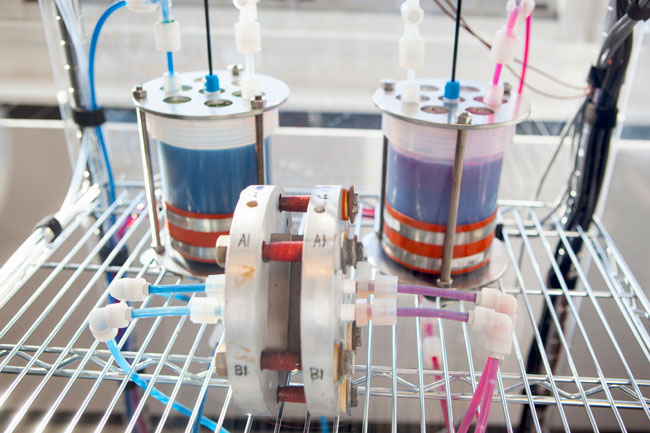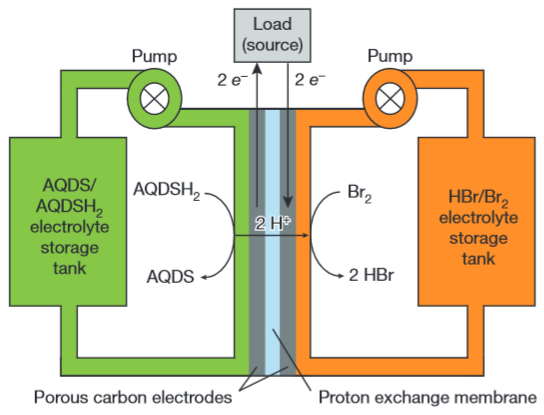Organic flow battery promises breakthrough for renewable energy
Harvard technology could economically store energy for use when the wind doesn’t blow and the sun doesn’t shine.
January 12, 2014

A
prototype flow battery in Aziz’s lab at Harvard School of Engineering
and Applied Sciences (credit: Eliza Grinnell, SEAS Communications.)
The new “flow” battery design relies on the electrochemistry of naturally abundant, inexpensive, small organic (carbon-based) molecules called quinones, which are similar to molecules that store energy in plants and animals.
It could be a cost-effective means of storing large amounts of electrical energy that could solve a key problem with electricity from renewable sources: energy from wind or sunshine is intermittent; it is not available when there is no wind, or at night, for example.
The battery was designed, built, and tested in the laboratory of Michael J. Aziz, Gene and Tracy Sykes Professor of Materials and Energy Technologies at the Harvard School of Engineering and Applied Sciences (SEAS).
[+]
Flow battery design
Flow
battery cell schematic. Discharge mode is shown; the arrows are
reversed for electrolytic/charge mode. (Credit: Brian Huskinson et al./Nature)
A flow battery stores energy in chemical fluids contained in external tanks — as with fuel cells — instead of within the battery container itself. The amount of energy that can be stored is limited only by the size of the tanks.
The design also permits larger amounts of energy to be stored at lower cost than with traditional batteries.
By contrast, in solid-electrode batteries, such as those commonly found in cars and mobile devices, the power conversion hardware and energy capacity are packaged together in one unit and cannot be decoupled. So they can’t maintain peak discharge power for typically more than an hour.
“Our studies indicate that one to two days’ worth of storage is required for making solar and wind dispatchable through the electrical grid,” said Aziz.
To store 50 hours of energy from a 1-megawatt power capacity wind turbine (50 megawatt-hours), for example, a possible solution would be to buy traditional batteries with 50 megawatt-hours of energy storage, but they’d come with 50 megawatts of power capacity. Paying for 50 megawatts of power capacity when only 1 megawatt is necessary makes little economic sense.
No expensive metals
For this reason, a growing number of engineers have focused their attention on flow battery technology. But until now, flow batteries have relied on chemicals that are expensive or difficult to maintain, driving up the energy storage costs.
The active components of electrolytes in most flow batteries have been metals. Vanadium is used in the most commercially advanced flow battery technology now in development, but its cost sets a rather high floor on the cost per kilowatt-hour at any scale. Other flow batteries contain precious metal electrocatalysts such as the platinum used in fuel cells.
The new flow battery developed by the Harvard team already performs as well as vanadium flow batteries, with chemicals that are significantly less expensive, and with no precious metal electrocatalyst.
Quinones are abundant in crude oil as well as in green plants. The molecule that the Harvard team used in its first quinone-based flow battery is almost identical to one found in rhubarb. The quinones are dissolved in water, which prevents them from catching fire.
Storage tank options
To back up a commercial wind turbine, a large storage tank would be needed, possibly located in a below-grade basement, said co-lead author Michael Marshak, a postdoctoral fellow at SEAS and in the Department of Chemistry and Chemical Biology. Or if you had a whole field of turbines or large solar farm, you could imagine a few very large storage tanks.
The same technology could also have applications at the consumer level, Marshak said. “Imagine a device the size of a home heating oil tank sitting in your basement. It would store a day’s worth of sunshine from the solar panels on the roof of your house, potentially providing enough to power your household from late afternoon, through the night, into the next morning, without burning any fossil fuels.”
Achieving commercial scale
Aziz said the next steps in the project will be to further test and optimize the system that has been demonstrated on the bench top and bring it toward a commercial scale. “So far, we’ve seen no sign of degradation after more than 100 cycles, but commercial applications require thousands of cycles,” he said.
He also expects to achieve significant improvements in the underlying chemistry of the battery system. “I think the chemistry we have right now might be the best that’s out there for stationary storage and quite possibly cheap enough to make it in the marketplace,” he said. “But we have ideas that could lead to huge improvements.”
By the end of the three-year development period, Connecticut-based Sustainable Innovations, LLC, a collaborator on the project, expects to deploy demonstration versions of the organic flow battery contained in a unit the size of a horse trailer. The portable, scaled-up storage system could be hooked up to solar panels on the roof of a commercial building, and electricity from the solar panels could either directly supply the needs of the building or go into storage and come out of storage when there’s a need.
Sustainable Innovations anticipates playing a key role in the product’s commercialization by leveraging its ultra-low cost electrochemical cell design and system architecture already under development for energy storage applications.
“You could theoretically put this on any node on the grid,” Aziz said. “If the market price fluctuates enough, you could put a storage device there and buy electricity to store it when the price is low and then sell it back when the price is high. In addition, you might be able to avoid the permitting and gas supply problems of having to build a gas-fired power plant just to meet the occasional needs of a growing peak demand.”
This technology could also provide very useful backup for off-grid rooftop solar panels — an important advantage considering some 20 percent of the world’s population does not have access to a power distribution network.
“The intermittent renewables storage problem is the biggest barrier to getting most of our power from the sun and the wind,” Aziz said. “A safe and economical flow battery could play a huge role in our transition off fossil fuels to renewable electricity. I’m excited that we have a good shot at it.”
The team
William Hogan, Raymond Plank Professor of Global Energy Policy at Harvard Kennedy School, and one of the world’s foremost experts on electricity markets, is helping the team explore the economic drivers for the technology.
Trent M. Molter, President and CEO of Sustainable Innovations, LLC, provides expertise on implementing the Harvard team’s technology into commercial electrochemical systems.
Roy G. Gordon, Thomas Dudley Cabot Professor of Chemistry and Professor of Materials Science, led the work on the synthesis and chemical screening of molecules. Alán Aspuru-Guzik, Professor of Chemistry and Chemical Biology, used his pioneering high-throughput molecular screening methods to calculate the properties of more than 10,000 quinone molecules in search of the best candidates for the battery.
Under the OPEN 2012 program, the Harvard team received funding from the U.S. Department of Energy’s Advanced Research Projects Agency – Energy (ARPA-E) to develop the innovative grid-scale battery and plans to work with ARPA-E to catalyze further technological and market breakthroughs over the next several years.
This work was supported by the Harvard School of Engineering and Applied Sciences, the National Science Foundation (NSF) Extreme Science and Engineering Discovery Environment, an NSF Graduate Research Fellowship, and the Fellowships for Young Energy Scientists program of the Foundation for Fundamental Research on Matter, which is part of the Netherlands Organization for Scientific Research (NWO).
Abstract of Nature paper
As the fraction of electricity generation from intermittent renewable sources — such as solar or wind — grows, the ability to store large amounts of electrical energy is of increasing importance. Solid-electrode batteries maintain discharge at peak power for far too short a time to fully regulate wind or solar power output. In contrast, flow batteries can independently scale the power (electrode area) and energy (arbitrarily large storage volume) components of the system by maintaining all of the electro-active species in fluid form. Wide-scale utilization of flow batteries is, however, limited by the abundance and cost of these materials, particularly those using redox-active metals and precious-metal electrocatalysts. Here we describe a class of energy storage materials that exploits the favourable chemical and electrochemical properties of a family of molecules known as quinones. The example we demonstrate is a metal-free flow battery based on the redox chemistry of 9,10-anthraquinone-2,7-disulphonic acid (AQDS). AQDS undergoes extremely rapid and reversible two-electron two-proton reduction on a glassy carbon electrode in sulphuric acid. An aqueous flow battery with inexpensive carbon electrodes, combining the quinone/hydroquinone couple with the Br2/Br− redox couple, yields a peak galvanic power density exceeding 0.6 W cm−2 at 1.3 A cm−2. Cycling of this quinone–bromide flow battery showed >99 per cent storage capacity retention per cycle. The organic anthraquinone species can be synthesized from inexpensive commodity chemicals. This organic approach permits tuning of important properties such as the reduction potential and solubility by adding functional groups: for example, we demonstrate that the addition of two hydroxy groups to AQDS increases the open circuit potential of the cell by 11% and we describe a pathway for further increases in cell voltage. The use of π-aromatic redox-active organic molecules instead of redox-active metals represents a new and promising direction for realizing massive electrical energy storage at greatly reduced cost.
(¯`*• Global Source and/or more resources at http://goo.gl/zvSV7 │ www.Future-Observatory.blogspot.com and on LinkeIn Group's "Becoming Aware of the Futures" at http://goo.gl/8qKBbK │ @SciCzar │ Point of Contact: www.linkedin.com/in/AndresAgostini
 Washington
Washington